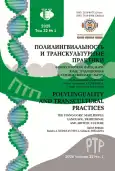Interpretation of Ornamental Compositions in the Costume Complex of the Tsarevokokshaisk Mari
- Authors: Kudryavtsev V.G.1
-
Affiliations:
- Mari State University
- Issue: Vol 22, No 1 (2025): THE FINNO-UGRIC MARI PEOPLE: LANGUAGE, TRADITIONAL AND ARTISTIC CULTURE
- Pages: 99-110
- Section: TRADITIONAL CULTURE
- URL: https://journal-vniispk.ru/2618-897X/article/view/326874
- DOI: https://doi.org/10.22363/2618-897X-2025-22-1-99-110
- EDN: https://elibrary.ru/GRVZJK
- ID: 326874
Cite item
Full Text
Abstract
The paper is devoted to the interpretation and analysis of ornamental compositions in the costume complex of the Tsarevokokshaysk Mari of the late 19th - early 20th centuries. The model of studying the artistic and semantic interpretation as “element - motif - ornamental zone” as a constructive pattern put forward by modern researchers-ornamentologists is acceptable in the analysis of the embroidery compositions of the ethnoterritorial group of the Tsarevokokshaysk Mari. The figurative interpretation of the ornamental compositions of the costume complex of the Tsarevokokshaysk (Yoshkar-Оla) group of Mari as the most striking artistic phenomenon and richly saturated with the meanings invested in them expresses the ethno-identifying feature of folk art. The embroidered ornamental image is a source of many symbolic meanings and serves as a means of communication. This type of artistic creativity reflects the cosmological model of the world, initially formed in metal and ceramic products, and later their pictorial symbolism passed to embroidery. The images of the sun were accompanied by universal signs of a rhombus, cross, swastika, images of the animal world included such representatives as a bear, elk / deer, horse, ornithomorphic ornament consisted of a duck, swan, wood grouse, black grouse. Particular emphasis was given to the vertically placed image of the world tree, anthropomorphic images and large solar signs. Today, the complexity of deciphering ornamental compositions lies in the layering of one image over another. In expressing its attitude to the external world, the ornament, first of all, is characteristic of the most conservative tradition of manual creativity, manifested in the design of festive and ritual embroidery of both women᾿s and men᾿s costume complexes. In them, along with aesthetic and artistic manifestations, the performing techniques of women᾿s manual craftsmanship are revealed. These abstracted or quite realistic embroidered images are connected with ideological patterns and have received the most diverse manifestations in the compositional solution of the costume complex of the Tsarevokokshaysk Mari.
About the authors
Vladimir G. Kudryavtsev
Mari State University
Author for correspondence.
Email: vladku2004@mail.ru
ORCID iD: 0000-0002-1421-1664
SPIN-code: 5970-1282
Doctor of Art History, Professor of the Department of Culture and Arts
1 Lenin Sq, Yoshkar-Ola, 424000, Russian FederationReferences
- Palaguta, I.V. 2020. “Ornament as a special type of art”. Artistic culture, no. 1, pp. 45–64. https://doi.org/10.24411/2226-0072-2020-00007 EDN: RBOERZ Print. (In Russ.)
- Bakirova, T.Sh. 2021. “Application of scientific achievements in ornamental art.” Crimean dialogues: culture, art, education, vol. 7, no. 15, pp. 85–95. EDN: SDFRYL Print. (In Russ.)
- Palaguta, I.V. 2021. “The experience of “theorizing” ornament: “hermeneutics” or bricolage?: Rec. on the book: Ivanov N.A. Ornament: Hermeneutics and glossary. Moscow: Eterna publ., 2018. 352 p.” Terra artis. Art and design, no. 2, pp. 152–157. https://doi.org/10.53273/27128768_ 2021_2_152 EDN: PFDZSA Print. (In Russ.)
- Molotova, T.L. 2020. Mari costume. Yoshkar-Ola: Nat. Museum named after T. Evseev. Print. (In Russ.)
- Pavlova A.N. 2014. “Soroka — headdress of the Tsarevokokshay Mari: genesis and semantic.” Modern problems of science and education, no. 1. 14 Sept. 2024. https://science-education.ru/ru/article/view?id=12015
- Pavlova, A.N. 2006. Costume of the Volga Finns as an ethnocultural phenomenon. Yoshkar-Ola: Mari State Univ. EDN: QQYNFP Print. (In Russ.)
- Golubeva, L.A. 1979. “Zoomorphic decorations of the Finno-Ugrians.” Archeology of the USSR. Collection of archaeological sources. E 1–59. Moscow: Nauka. EDN: WFZKFH Print. (In Russ.)
- Bolshov, S.V., Bolshova, N.A., Danilov, O.V. 2008. Ancient cult monuments of Mari El (based on archaeological, ethnographic, folklore and historical materials). Yoshkar-Ola: Mari State Univ. EDN: QPOCDT Print. (In Russ.)
- Shutova, N.I. 2015. “History of the origin and semantics of the lunar sign Tolyze.” Bulletin of the Udmurt University, vol. 25, issue 4, pp. 87–94. Print. (In Russ.)
- Kryukova, T.A. 1951. Mari embroidery. Leningrad. Print. (In Russ.)
- Evseev, T.E. 2002. Ethnographic collections. Yoshkar-Ola: Mari book publishing house. Print. (In Russ.)
- Yakovleva, V.Ya. 1951. “About Mari embroidery.” Scientific notes of the Mari Research Institute of Language, Literature and History, vol. 4, pp. 245–265. Print. (In Russ.)
- Kudryavtsev, V.G., and A.N. Pavlova. 2023. The art of Mari embroidery. Yoshkar-Ola: Mari book publishing house. Print. (In Russ.)
- Pavlova, A.N. 2006. Costume of the Volga Finns as an ethnocultural phenomenon. Yoshkar-Ola: Mari State Univ. EDN: QQYNFP Print. (In Russ.)
- Ivanov, N.A. 2015. “Hermeneutics of ornament: towards a methodology for interpreting ornamental compositions.” International Journal of Cultural Research, vol 20, no. 3. pp. 14–25. EDN: WBMDUB Print. (In Russ.)
- Shigurova, T.A. 2021. “Semantics of fabric as the basis of Mordovian embroidery.” Finno-Ugric world, vol. 13, no. 3, pp. 308–319. https://doi.org/10.15507/2076-2577.013.2021.03.308-320 EDN: OZKPLS Print. (In Russ.)
- Tokpulatov, V.G. 2017. “Basic meta-projects of the culture of the Mari people.” Historical, philosophical, political and legal sciences, cultural studies and art history. Questions of theory and practice, vol. 86, no. 12-4, pp. 178–180. EDN: ZXHDHT Print. (In Russ.)
Supplementary files









